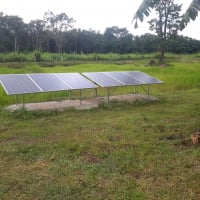Wiring a Battery Monitor Shunt.
Bass-O-Matic
Registered Users Posts: 45 ✭✭
I'm probably overthinking this. My battery bank of 2 Golf Cart batteries is grounded to the chassis of my RV. If I want a Battery Monitor with a Shunt... that's where I put it right?
Does it matter that I have another ground at the back of the trailer? Eg... I run a big fat 4guage wire to the back. Where I have another fuse box for the stereo and a few lights... and those ground to a ground bar and that ground bar is attached to the Chassis in the back.
Just one shunt at the batts I'm guessing since all power would flow through that ground wire.
Does it matter that I have another ground at the back of the trailer? Eg... I run a big fat 4guage wire to the back. Where I have another fuse box for the stereo and a few lights... and those ground to a ground bar and that ground bar is attached to the Chassis in the back.
Just one shunt at the batts I'm guessing since all power would flow through that ground wire.
Right?
Follow up. I have plenty of cheap voltmeters. I usually just watch the voltage. When it gets at or below 12... I charge stuff up. Some chart somewhere told me that's good enough. Or do I reallllly need a Battery Monitor reading amps/current/charge/ discharge?
Thanks
Thanks
Comments
-
I would connect the shunt to the neg. terminal of the battery. Everything else beyond that
2.1 Kw Suntech 175 mono, Classic 200, Trace SW 4024 ( 15 years old but brand new out of sealed factory box Jan. 2015), Bogart Tri-metric, 460 Ah. 24 volt LiFePo4 battery bank. Plenty of Baja Sea of Cortez sunshine.
-
Some folks just use a voltmeter to monitor the bank... As long as the voltage and SG ranges (from discharged to absorb charging voltage/time and SG levels) are good---You really do not need the shunt and metering.
If you have others using the home/cabin when you are not there--Then a battery monitor of some sort (voltage based, shunt based, etc.) makes things a bit easier. When you see "this" on the meter, and no sun in forecast, cut power usage or start the genset and run until you see "that"...
Some others really like charts, graphs, and hard data. How much energy did you use, how much energy was charged back into the battery--Do you have enough extra energy to run a microwave or coffee maker, etc.
The closer you run your system "to the limits" (draining battery bank, some days not enough sun to fully recharge bank, large DC/AC loads, etc.), then the details from a shunt based battery monitor can help you understand those limits.
Also, flooded cell lead acid batteries let you measure the specific gravity of your cells... The "gold standard" for state of charge and general cell health. If you have sealed/AGM/etc. batteries, then a battery monitor can be a big help to understand how your batteries are doing.
-BillNear San Francisco California: 3.5kWatt Grid Tied Solar power system+small backup genset -
Would have to agree with Bill, having fancy displays can often lead to complacency, shunt based battery monitoring is fine if there is a single charge cycle then discharge, in a dynamic system where there is charging as well as dischargeing similtaniously the accuracy tend to be less consistant, AKA drift. Undestanding the battery's needs and limitations is far more important, having the correct tools will make the job that much easier.
The one BMS I have has seperate charge and discharge shunts, despite this it cannot accurately calculate the energy in/out of the battery according to its watt hour meter, I simply ignore it as the information is of little relevance.1500W, 6× Schutten 250W Poly panels , Schneider MPPT 60 150 CC, Schneider SW 2524 inverter, 400Ah LFP 24V nominal battery with Battery Bodyguard BMS
Second system 1890W 3 × 300W No name brand poly, 3×330 Sunsolar Poly panels, Morningstar TS 60 PWM controller, no name 2000W inverter 400Ah LFP 24V nominal battery with Daly BMS, used for water pumping and day time air conditioning.
5Kw Yanmar clone single cylinder air cooled diesel generator for rare emergency charging and welding.
Categories
- All Categories
- 233 Forum & Website
- 141 Solar Forum News and Announcements
- 1.4K Solar News, Reviews, & Product Announcements
- 199 Solar Information links & sources, event announcements
- 900 Solar Product Reviews & Opinions
- 256 Solar Skeptics, Hype, & Scams Corner
- 22.5K Solar Electric Power, Wind Power & Balance of System
- 3.5K General Solar Power Topics
- 6.7K Solar Beginners Corner
- 1K PV Installers Forum - NEC, Wiring, Installation
- 2.1K Advanced Solar Electric Technical Forum
- 5.6K Off Grid Solar & Battery Systems
- 429 Caravan, Recreational Vehicle, and Marine Power Systems
- 1.1K Grid Tie and Grid Interactive Systems
- 656 Solar Water Pumping
- 816 Wind Power Generation
- 624 Energy Use & Conservation
- 623 Discussion Forums/Café
- 315 In the Weeds--Member's Choice
- 75 Construction
- 125 New Battery Technologies
- 108 Old Battery Tech Discussions
- 3.8K Solar News - Automatic Feed
- 3.8K Solar Energy News RSS Feed

